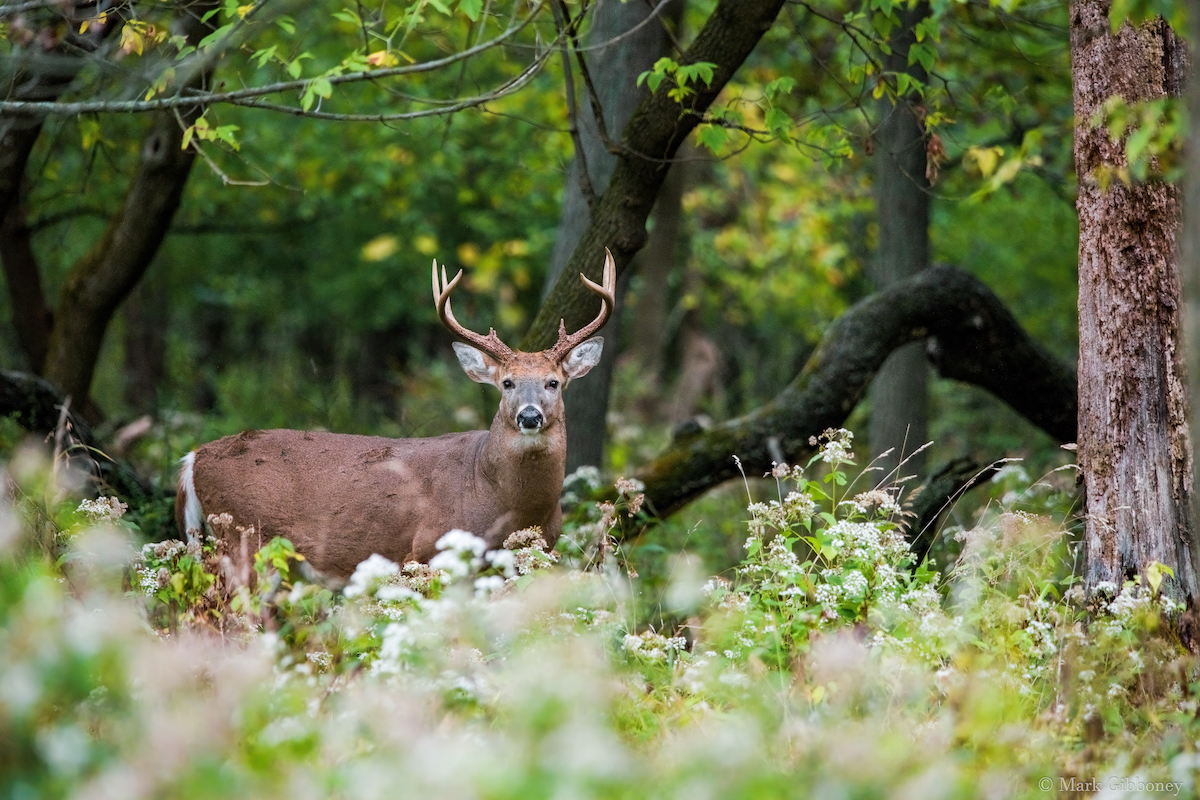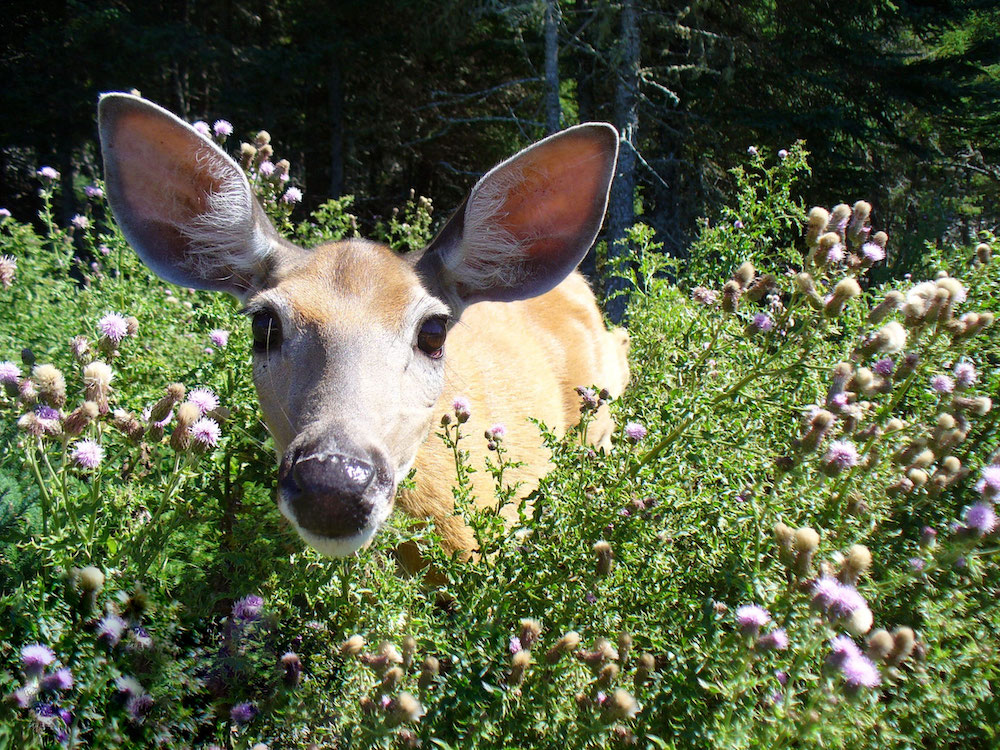
Photo by Mark Gibboney.



Photo by Mark Gibboney.
As the COVID-19 pandemic spread around the world, wildlife biologists began to wonder: Do deer get COVID-19? The U.S. Department of Agriculture (USDA) had previously reported COVID-19 in domestic and captive animals including dogs, cats, tigers, lions, snow leopards, otters, gorillas and farmed mink. But what about a wild species such as white-tailed deer that can move long distances, and which are hunted, putting them in close contact people? If deer are susceptible to SARS-CoV-2, the virus that causes COVID-19, what does that mean for human and deer health?

One of the first studies looking for evidence of the virus in deer was conducted by the USDA Animal and Plant Health Inspection Service (APHIS) Wildlife Services program in which they analyzed serum samples from wild white-tailed deer for antibodies to SARS-CoV-2. The tests used to analyze the deer samples in this study could only detect antibodies, not the virus itself, though other studies have since found the virus in wild deer. More on that in a bit.
In the Wildlife Services study, between January 2020 and March 2021 researchers collected a total of 481 samples from white-tailed deer in Illinois, Michigan, New York and Pennsylvania. Results of this study showed that some of the deer populations in those four states had been exposed to SARS-CoV-2. Illinois deer had the lowest exposure with 7 percent of 101 samples containing antibodies to SARS-CoV-2. In Michigan, 67 percent of 113 samples contained antibodies; in New York 19 percent of 68 samples contained antibodies; and in Pennsylvania 31 percent of 199 samples contained antibodies. Here was evidence that free-ranging white-tailed deer could become infected with the virus. But what does that mean? Is there cause for concern? Knowing that people would have such questions, APHIS wrote a short Question & Answer guide about the results of this study to highlight what is currently known and not known about transmission of COVID-19 and deer.
The APHIS researchers pointed out that their findings should not be used to draw conclusions about the prevalence of the virus in deer populations throughout these states. More sampling would need to occur to establish whether or not deer in other parts of these states have been exposed to the virus. They did, however, note that the high seroprevalence observed in deer in multiple counties and states suggested the possibility of spread within local deer populations. Clearly, more studies were needed, and other researchers were already on the case. Free-ranging wild white-tailed deer have also tested positive for exposure to SARS-CoV-2 in Iowa, Ohio, Oklahoma, and in Quebec, Canada.

It is not currently known how wild deer were originally exposed to the virus. Tracking the spread of viruses and disease through wild populations is difficult, but researchers think that the infected deer were likely exposed through multiple sources: the environment, by other animal species and by people. Once infected, and given their gregarious nature, deer likely began to spread the virus among other local individual deer.
It was noted that the deer in the Wildlife Services study did not show any clinical signs of illness. The researchers explained that the presence of antibodies was the result of the immune system response of the deer to being previously infected and did not necessarily suggest a current infection. Other research has shown that white-tailed deer are susceptible to SARS-CoV-2 infection, but in studies where captive deer have been exposed to the virus, they either did not show signs or had mild signs of illness, including coughing and raspy breathing.
Which brings us back to the question of human health. There is currently no evidence that people can get COVID-19 by preparing or eating meat from a deer that is infected with SARS-CoV-2. Heat kills the virus. However, hunters should always practice good hygiene when processing animals by following these food safety recommendations from USDA Wildlife Services:
• Do not allow contact between wildlife and domestic animals, including pets and hunting dogs.
• Do not harvest animals that appear sick or are found dead.
• Keep game meat clean and cool the meat down as soon as possible after harvesting the animal.
• Avoid cutting through the backbone and spinal tissues and do not eat the brains of wildlife.
• When handling and cleaning game: Wear rubber or disposable gloves and do not eat, drink, or smoke while handling the animal.

• When finished handling and cleaning game: Wash your hands thoroughly with soap and water. Clean knives, equipment, and surfaces that were in contact with game meat with soap and water and then disinfect them.
• Cook all game meat thoroughly (to an internal temperature of 165 °F or higher).
• Check with your state wildlife agency regarding any testing requirements for other diseases and for any specific instructions regarding preparing, transporting, and consuming game meat.
The results of the initial studies indicate that white-tailed deer can serve as potential reservoir hosts for SARS-CoV-2. What that will mean for the long-term persistence of the virus, or its future evolution and variants, is not yet known. Researchers believe that there has been spillover from humans to deer and there is known deer-to-deer transmission. Spillback from deer to humans may be possible but there is not yet definitive evidence. Both observational and experimental studies in free-ranging, captive, domestic, and farmed animals have shown that as of January 2022, SARS-CoV-2 has been shown to infect at least 29 non-human mammalian species. As part of continued research and monitoring of deer populations, future research should investigate whether predators and scavengers that interact with deer may become infected with the virus as part of a strategy for early detection of variants or other coronaviruses.
In Illinois, more research is already under way to better understand how SARS-CoV-2 is impacting deer. Beginning in November 2021, the USDA Wildlife Services collected opportunistic samples at Illinois Department of Natural Resources hunter-harvest check stations and from other sites in Illinois. This work is ongoing, and the results of that study will be shared in a future article in OutdoorIllinois Journal.
Laura Kammin is a Natural Resources Specialist with the National Great Rivers Research and Education Center. She formerly held positions at Illinois-Indiana Sea Grant, University of Illinois Extension, Prairie Rivers Network and the Illinois Natural History Survey. She received her master’s degree in wildlife ecology from the University of Illinois, Urbana-Champaign.
Submit a question for the author